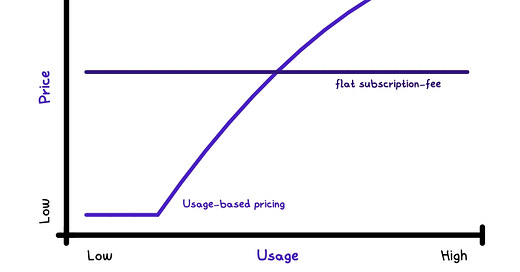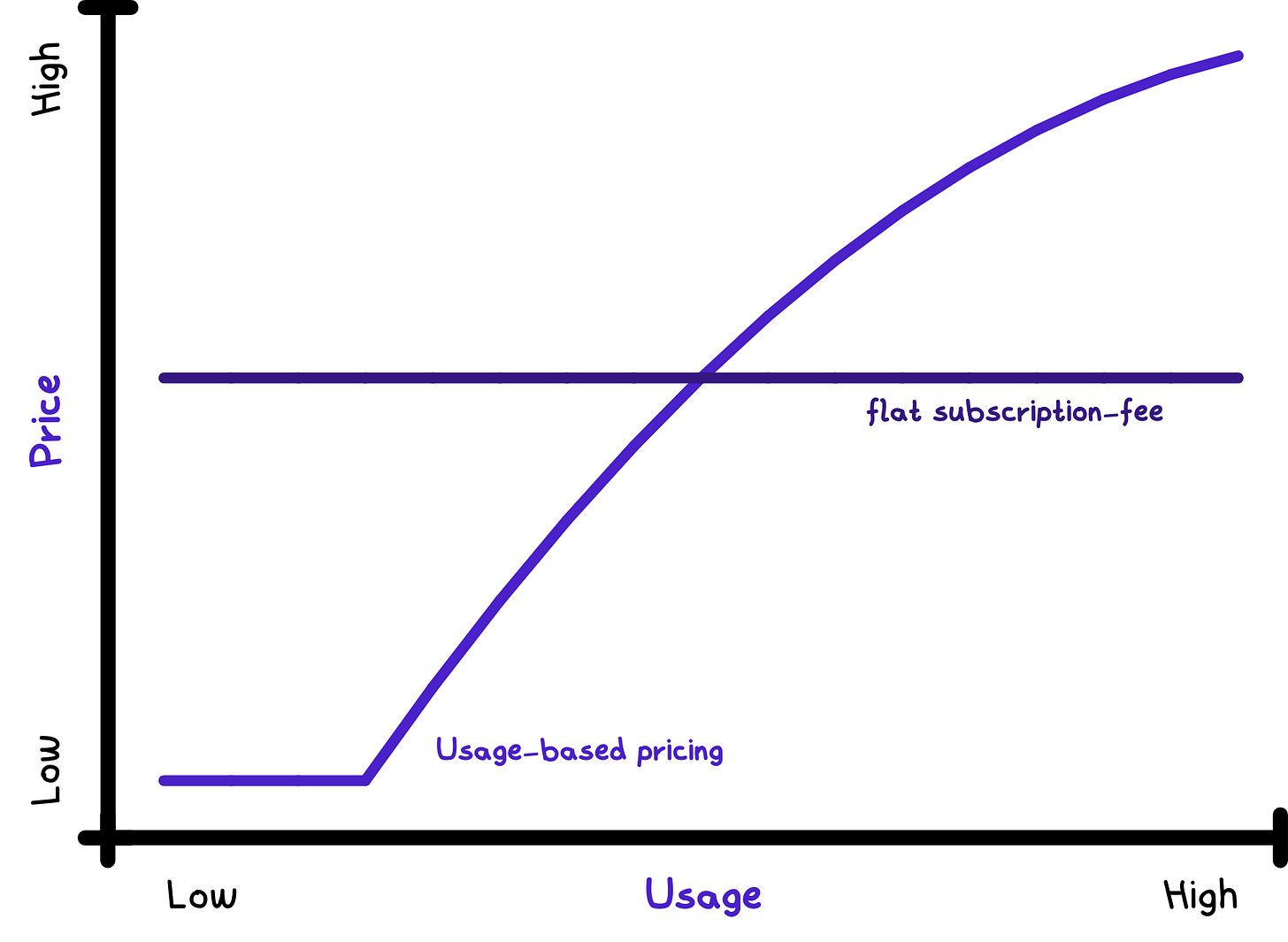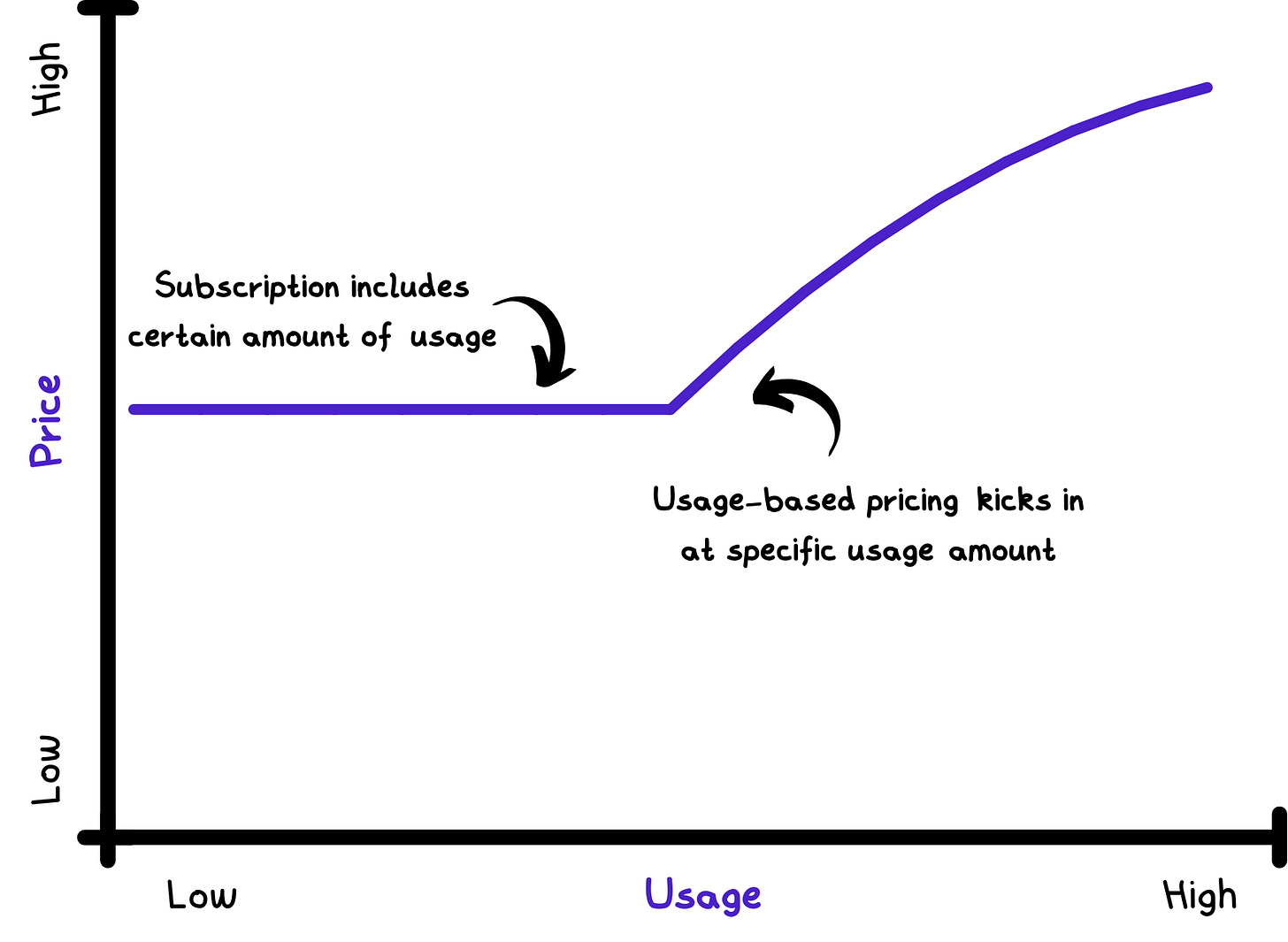Choosing the right pricing strategy can make or break your growth. Today, we're looking into one of my favorite topics: usage-based pricing vs. flat subscription fees. What are they? How do they work? And most importantly, which one is right for you? Let me get straight to the point.
What are flat subscription fees?
Subscription fee pricing is like your gym membership. Whether you go once a day or once a month, what you pay is the same. It's predictable. Businesses love predictability. This model works wonders for companies that offer services or products that benefit from regular use.
Examples:
Products like Netflix or Spotify where you pay a fixed monthly fee for unlimited access.
Gym memberships, where you pay a monthly fee to access the facility regardless of how often you visit.
What is usage-based pricing?
Imagine paying for exactly what you use, no more, no less. That's usage-based pricing in a nutshell. It's like paying for gas:
Drive more; pay more.
Drive less, pay less.
This model can work well if you have a diverse customer base that varies in both usage and ability to pay for your service. An example would be cloud computing companies, charging per usage makes it possible for small startups to pay hundreds of $ per month, while large enterprises pay millions. Imagine AWS would have to find a fixed monthly price for their service, it would be impossible. And the best part is: it's fair. Customers love fairness. Customers only pay for what they use.
Examples:
Cloud services like AWS or Azure charge based on the data you use or the computing power you consume.
Mobile phone plans bill you based on the data or minutes you've used over the month - yet this is often combined with a certain threshold amount before you slip into a “pay-as-you-go” model. (Flashbacks of accidentally opening the browser on my phone, when I was a child, with this one ☠️)
The Main Differences
1. Predictability
Subscription Fee: Customers know what they’ll pay each month, which is great for budgeting.
Usage-Based: It is not clear what the bill will be at any month, which can be an entry barrier for customers.
2. Flexibility
Subscription Fee: The price is the same even if your customers do not use the product for a month. (Hence why SaaS businesses try to get customers back into the product all the time, as a break in usage often leads to the customer leaving)
Usage-Based: Costs align with use. Less usage, less cost. More usage, more cost. Simple.
3. Customer Attraction
Subscription Fee: Attracts users who prefer unlimited access without worrying about overages.
Usage-Based: Appeals to cost-conscious users who prefer paying only for what they use.
4. Revenue Stability
Subscription Fee: Provides steady, predictable revenue. Easy for future planning.
Usage-Based: Revenue can fluctuate, so planning and forecasting will be trickier.
5. Fairness and Perception
Subscription Fee: Can seem unfair to light users who pay as much as heavy users.
Usage-Based: Seen as more equitable since payments are aligned with consumption.
When to Use Which?
Go Usage-Based If:
Your product’s usage is easy to measure.
Your customers have significantly varying usage patterns.
You want to attract smaller, more price-sensitive customers.
Go Subscription Fee If:
You offer a product that’s meant to be used frequently.
You value revenue predictability to fund operations and growth.
Your costs do not explode with high usage.
Real-World Examples
Think about Adobe and Microsoft. They shifted to subscription models, simplifying their revenue streams and aligning costs with how businesses use their products. On the other side are utility companies or cloud service providers who charge based on consumption because their costs are directly tied to consumption, so both heavy and light users can use their services.
Which One Wins?
The truth? There's no one-size-fits-all answer. The best pricing model depends on your business, customer behavior, and market conditions. The key to success is understanding your customers deeply—what they value, how they use your product, and how they react to pricing changes.
Remember, the ultimate goal is to make your pricing as attractive as possible to your customers while ensuring it aligns with your business needs. Sometimes, that might even mean blending both models to strike the perfect balance.
Whatever you choose, make sure it fits your narrative. Because at the end of the day, the right pricing strategy is not just about numbers—it tells a story. What story are you telling your customers with your pricing strategy? Both messages: “All-you-can-eat” and “only pay what you use” can be very powerful if they fit your brand and strategy.
Now, take this knowledge, discuss it with your team, and decide how you can apply these insights to your business model. And don't forget to share this article if you found it helpful—it might just be the perfect read for someone in your network who's currently stuck with the same decisions. Happy pricing!
VERSUS Series
The VERSUS series is a set of 8 newsletter articles (2 per week) that answer questions PMs ask themselves all the time. Check out the other articles below!







